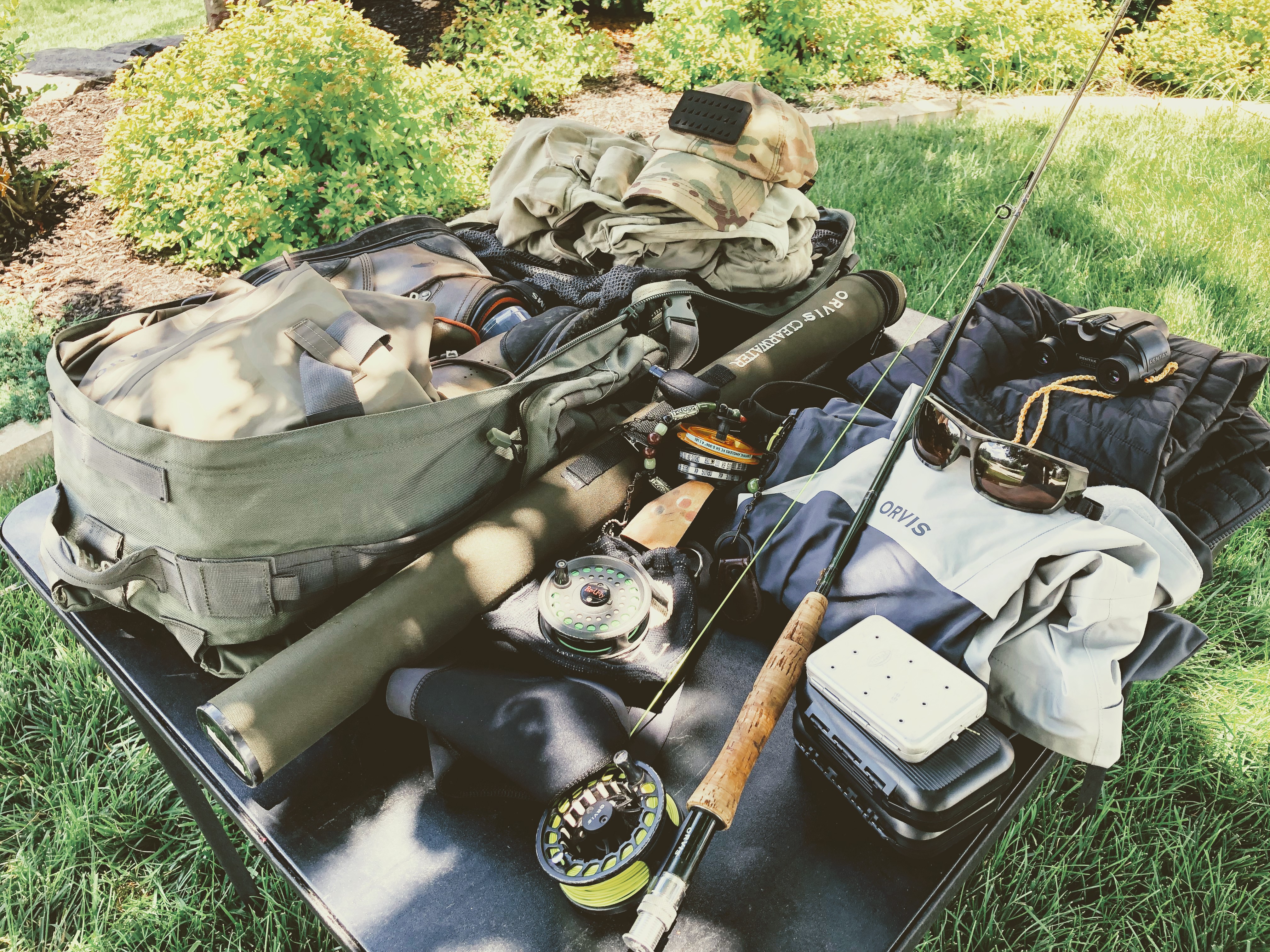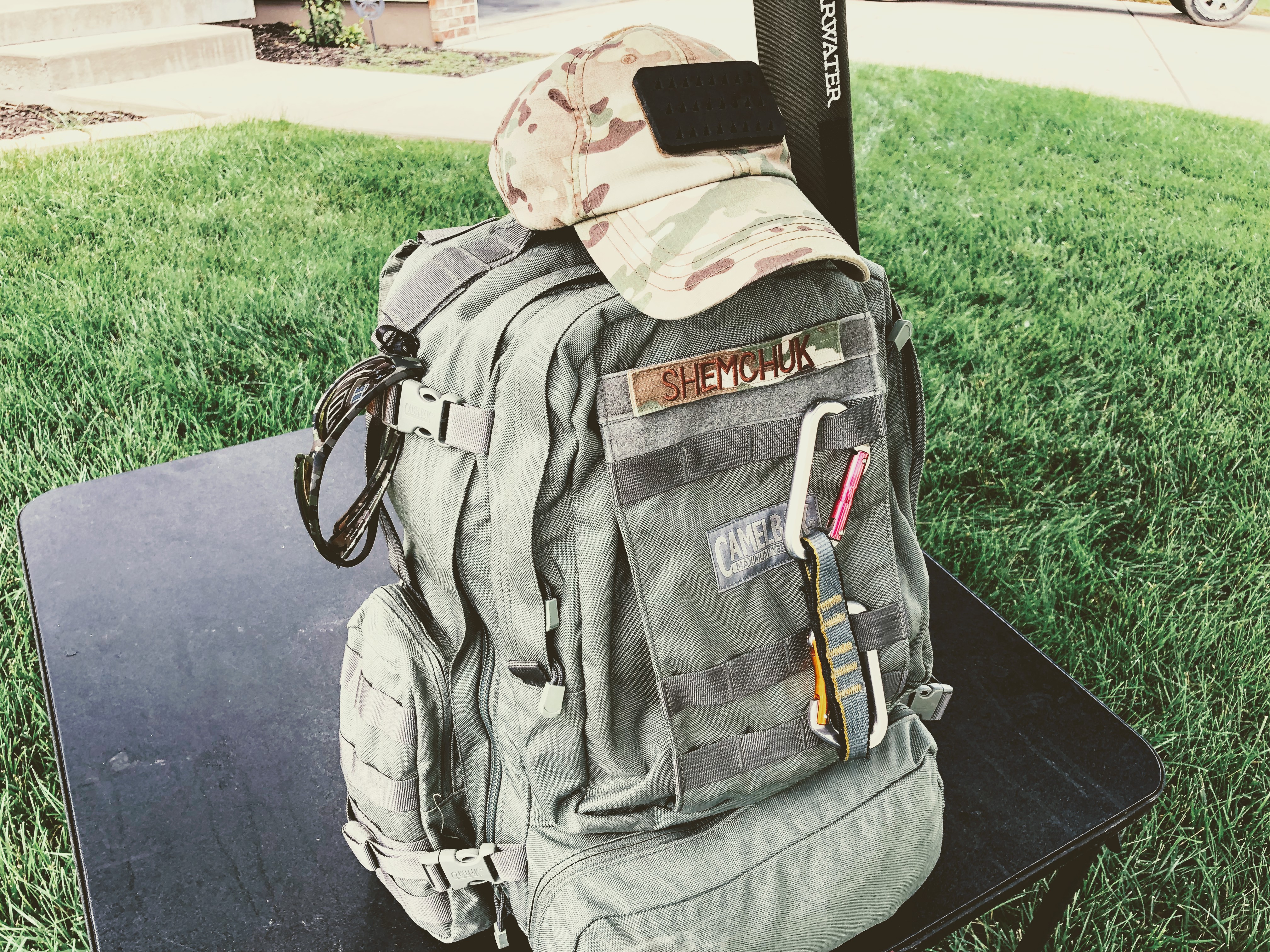I know what I need in life, and I don’t need much. Turns out packing for a fly fishing trip is no different. I travel several times a year these days for the Shemchuk Rendezvous and jamming stuff into my bag in pursuit of trout has taught me the value of packing light.
The two guiding principles I have reached when attempting to pack light for any fly fishing trip are to know what you need and to need less stuff. Easier said than done? Let’s break it down.
When I pack for a fly fishing trip, I break up the things I need to bring into three categories: gear, clothes, and other stuff.
READ: WADEOUTTHERE | The Rendezvous – More Than a Fly Fishing Trip.
Gear
The first thing I do is gather up and organize my fly fishing gear.
Rod. Typically, I only take one rod. If you have another similar rod in size and weight that will work for catching the type of fish you are going after, bringing it along as a spare is a good idea.
Rod case. You can put both rods into the one case to save room.
Reel. I will bring two reels. One is a spare.
Boots. I only bring them if it is going to be cold enough for waders, otherwise I bring my river shoes. If you prefer the stability of a boot over the shoe, then you can bring the boots without the waders. Don’t forget your neoprene socks if you do this.
Waders. I do not bring them if the temperatures will be in the mid-seventies or warmer on the river. Everybody has different comfort levels here, but if it is going to be warm weather, I would rather wet wade the river.
READ: WADEOUTTHERE | Dear Bill, About Those Waders.
Fly Fishing Vest. I am fifty-fifty on bringing my vest. Depending on the duration of the trip, I may take what I need from the vest and leave it at home. Since I often fish with just a fishing necklace, this works well for me. I always go through my vest to check that I have enough accessories for the trip and make a list as I go of things I need to re-supply. Items I am accounting for are leaders, tippet, strike indicators, split shot, floatant, forceps, nippers, wader repair glue, and fly boxes.
Leaders. I am a leader killer. I make sure I have about three leaders for every two days of fishing — Just in case. They take up no room.
Tippet. Usually I have two spools of tippet for each size — 3X, 4X, 5X, and 6X. One on my necklace, and one in my vest as a back-up.
Having extra tippet is like having a spare tank of gas for the grill. You don’t want to be in the middle of cooking a delicious steak when you realize you are out of propane.
Strike indicators. I prefer the little foam footballs. I have some yarn indicators too for nymphing slower more delicate water. Everyone has a different prerogative in the realm of strike indicators. Make sure you have enough of whatever you like.
Split Shot. I find the less fancy the better.
Gink. This is my preferred floatant. Works great. Funny name.
Forceps. I like the longer skinnier surgeon forceps.
Nippers. Keep it simple.
Wader repair kit. Murphy’s Law. I only bring this because if I don’t, it’s a guaranteed hole in my waders. Small patch and some glue are all you need.
Fly boxes. I don’t take every fly box I own. I will take a dry fly box, a nymph box, and a streamer box. I have a couple of small round containers that I can use for flies that I may buy at the fly shop. I go through my flies and take the ones I think I will need. This decision is based on what I read has been fishing good and a call to the local fly shop. My fly fishing necklace has a small fly box attached as well. Each night of the trip I fill that with the flies I will mostly be using on the river the next day.
Flies. I tie as much as I can ahead of time. It is always worth a phone call to ask a guide what flies I should tie or acquire. I take what I think I will need, and I am prepared to pick up some flies once I get there.
Fishing Necklace. I have almost completely gone away from wearing a fly fishing vest while I fish. This is strictly personal preference. I usually fish with my necklace and leave my vest in the boat or in the truck for re-supply. My fly fishing necklace has almost everything I need. The necklace combined with a shirt or jacket that has a couple zipper pockets on the chest works great for me. I will keep split shot, leaders, and a small fly box in my chest pockets.
Clothes
The second thing I do is plan out my clothes.
My philosophy on fly fishing clothing can be summarized by least, light, and layers.
I only pack the least amount of clothing for what I know I will absolutely need and wear. I make sure that what I do need to take is light and quick drying. And I ensure that I can layer up or down for comfort, depending on the weather.
I bracket my trip with the clothes I will need for two days’ worth of travel and then plan clothing for the days in between.
My travel clothes consist of one pair of pants to wear out and back on the airplane. I do not take these on the river. I also bring two collared fishing shirts with zipper chest pockets. I wear one on the airplane and then I use it as a layer on the river. I save the other collared shirt for traveling home.
I wear my river shoes on the airplane and then take them in the river if its warm weather. They will usually dry overnight, so I wear them traveling home as well.
I bring wading boots only if I am bringing waders. If you do not think you need waders, but want more stability than river shoes, then you can skip them and bring your wading boots with a set of neoprene socks.
Unless the weather is forecast to be gorgeous the entire time, I will bring a waterproof coat that is very light, like a shell. This light layer keeps me dry if it starts to rain and it also provides some warmth with layers underneath if it gets cold.
If the weather is forecast to be very cold, I bring a warm jacket for under my waterproof shell. I highly recommend down jackets for this. They are light weight, very efficient, and take up almost no room while packing.
I bring one long sleeve shirt to help protect me from the sun and be an extra layer for warmth if required.
A pair of light quick drying pants are great for on the river and off. If you don’t want to wear them after fishing because they are still wet, then you can wear your travel pants.
I only take long johns only if I know it will be extremely cold.
I bring underwear for every day and socks for every other day. Typically, I do not wear socks with my waders. If I know I will be wearing my waders, then I do not need as many socks.
I always bring my Condor baseball cap that I was issued for my last deployment to Afghanistan. It has Velcro on the front and back. On the back is a patch with my last name — a holdover from my time in the Air Force. The front Velcro was originally meant to display my rank. Now I have a homemade fly patch I wear while fishing and an American flag for off the river.
My Achilles heel of light packing are “fuzzies”. Fuzzies is my term for sweats or pajamas. I want nice warm clothes to relax in when I get back from fishing. I pack very light sweats and a pair of thick socks that I can wear around the cabin or hotel each night.
Other Stuff
The last thing I tend to while packing for my fly fishing trip is ensuring I remember to bring all the other stuff I may need that is not gear or clothing. If you are trying to pack light, you will have to keep these items to a minimum. This list is not inclusive. There may be things you would like to add, but this is basically all I need in addition to gear and clothes:
License.
Toiletries. I only take what I need and it all fits in a small zip lock bag.
Sunglasses. I always forget the dang sunglasses. I prefer polarized with the neck strap. You do not have to spend a ton on these.
Phone
Phone charger.
Wallet.
Watch.
The Bag
When I pack for a fly fishing trip, I want my bag to have utility and good storage, but also be something that will fit in the overhead space on an airliner. I have a Camelbak backpack that works great. It was also issued to me for deployment to Afghanistan.
I like my bag because it is meant to be tactical. It has multiple pockets, zippers and straps.
I can use these to tie things down or hook things up. A couple carabiners come in handy in this department. It also has a large main compartment that opens all the way up like a book and lays flat so I can pack it like a suitcase. I have taken the water bladder out and removed the waist belt. Condor also makes some good backpacks. These types of tactical bags are extremely rugged and durable. Perfect for your next Rendezvous.
How I Actually Pack the Bag
I open the main compartment of the bag up completely. First, I pack all my gear as flat as I can. This makes the first layer. I stuff my fishing boots with reels, socks, and fly boxes, then pack them neatly in the bottom of the bag. Waders get rolled up and scrunched into the bag they came with, then packed above the boots at the top of the bag. I put all my gear in my vest, except fly boxes. The necklace gets wrapped in the vest and then stuffed between the waders and the boots. My next layer is the rest of my clothes sandwiched between my pants and my jacket. The last item I pack in the main compartment is the net. I put it on top of the clothes so the handle can stick out the top of the bag as I zip it up.
Outside pouches hold my other stuff like toiletries and phone chargers. I may strap a jacket to the outside of the bag. I hand carry the rod or hook it to straps on bag.
A fly fishing trip should be an adventure. If you know what you need and can commit to needing less stuff, I know you will find packing much easier. I think you will also find that you do not need much stuff at all to make your trip memorable. The next time you have to pack for a fly fishing trip, keep it tactical. Pack light and Wadeoutthere.
VR,
Jason Shemchuk
WADEOUTTHERE
@wadeoutthereflyguy
jason@wadeoutthere.com






No Comments